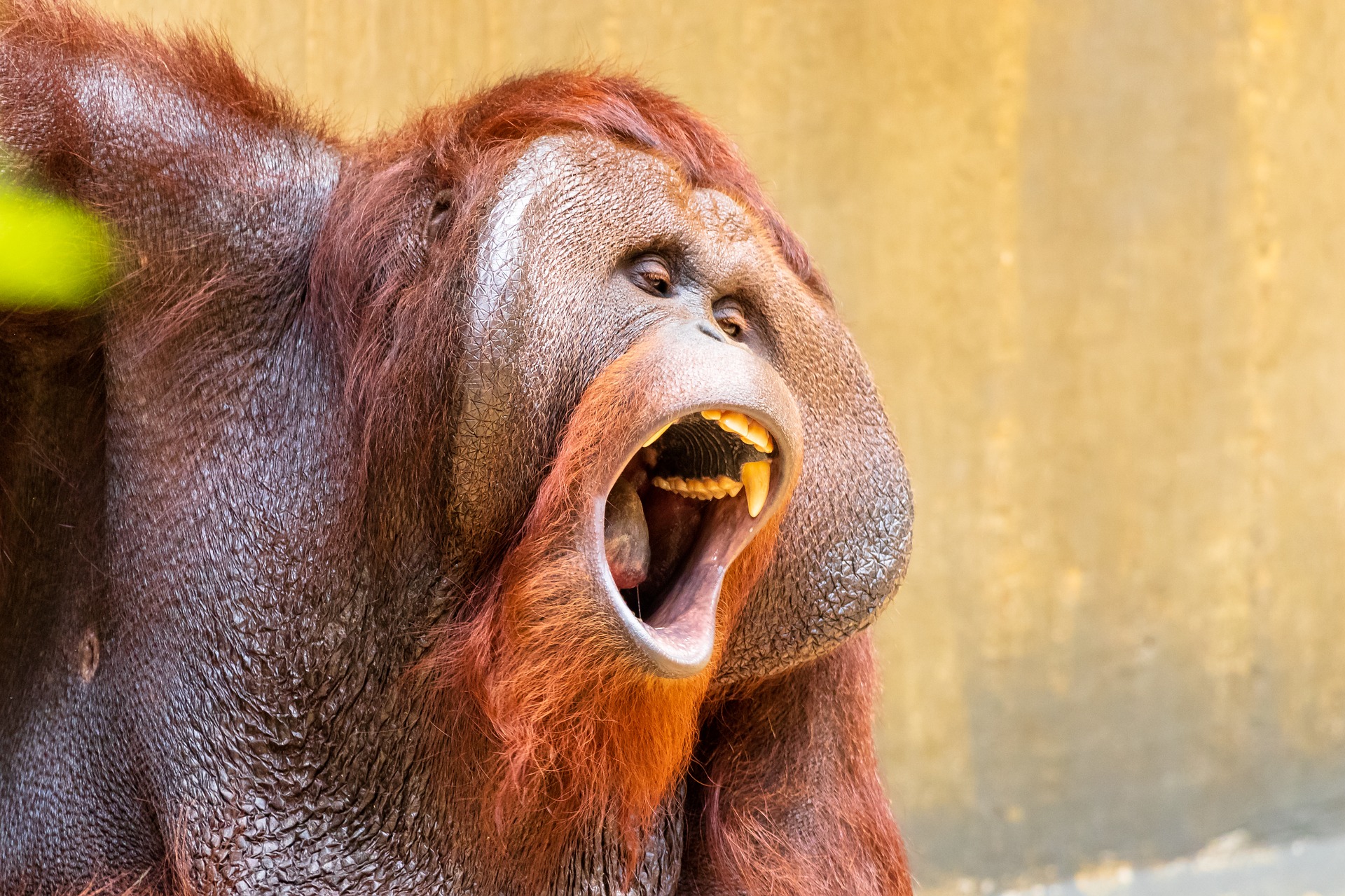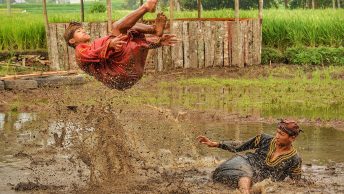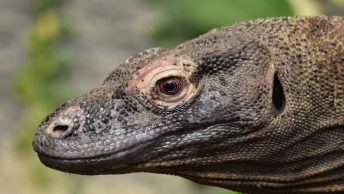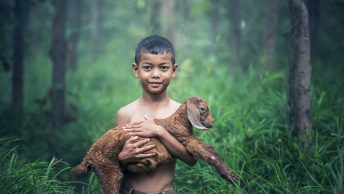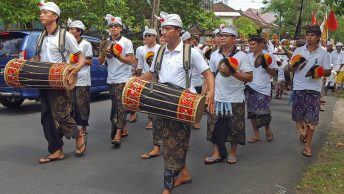The name Orangutan can be translated as “man from the forest”. In Malay (the official language of Malaysia and Indonesia) “orang” means man or person and “hutan” means forest. Today, orangutans can only be found in the wild on the islands of Sumatra and Borneo. At one time they probably lived all over Southeast Asia. Their natural habitat is the rainforest. Unlike the other great apes, they spend most of their lives up in the trees. The orangutans have developed an amazing ability to swing through the treetops, and there they also spend the nights in “nests” made of leaves and branches. Their reddish-brown hair color also makes them unique in the monkey world.
Arms over 2 metres
An adult male is twice the size of a female and can reach a height of 1.4 meters and a weight of 70-90 kilos. The long and very strong arms can span more than 2 metres. So they are specially adapted to swing from tree to tree, while the legs are short. This gives the monkeys a disadvantage on the ground, and they therefore rarely come down from the trees. Like humans, they have hands with four long fingers and a thumb that can be used to grasp things.
Adult males spend time alone
Small groups of females and cubs may spend the day together to find food. The food mainly consists of more than 300 different types of fruit, leaves, bark and flowers. Termites and other insects are also on the menu. Frequent rain showers provide water. Adult males spend most of their lives alone. With the help of a bag filled with air that hangs down from the neck, they can produce the so-called “long call”. It is a sound intended to attract females ready for mating and to mark the territory. A human can hear this sound at least a kilometer away. A female and a male can live together for a few days until mating is completed. Then they go their separate ways.
Will be between 35 – 50 years
After a gestation period of eight to nine months, the female gives birth to a baby that she raises for approximately six years before mating again. A female orangutan will thus only give birth to 4-5 cubs during her lifetime. A wild orangutan can live to be 35-40 years old. In captivity, they can live up to 50 years. A young orangutan must learn everything from its mother. Where it finds food, what it can eat and when in the year it can eat the different fruits. This is very important to avoid wasting valuable energy by looking for fruit trees with fruit that are not ripe.
Research has shown that the monkeys must have a very detailed map in their heads of the vast forest to find the correct fruit trees for the season. The young must also learn which fruit is edible and how to eat it. Many are protected by sharp thorns and thick skins.
Man’s closest relatives
Orangutans are considered highly intelligent and one of our closest relatives. They share about 97% of our DNA, this unfortunately makes them susceptible to human diseases. A common cold can be very dangerous for an orangutan. They have senses like us, including hearing, sight, smell and taste. Some orangutans are known to use certain objects as tools. They can use a leaf as an umbrella when it rains or as a cup to drink from. They can even chew leaves and use them as a sponge to soak up drinking water. Each evening they construct a new “nest” up in a tree in which they sleep at night. A mother and child share such a nest.
Sumatra and Borneo
In Indonesia, wild orangutans are only found in the tropical rainforests of North Sumatra and Borneo. The Borneo subspecies (Pongo pygmaeus pygmaeus) has a round face and dark red hair. While the subspecies in Sumatra (Pongo pygmaeus abelii) has a narrower face and lighter hair. These two groups have been geographically separated for a very long time. Which is the reason for the physical differences. Scientists do not agree whether these two groups belong to different subspecies. But they definitely belong to the same species as they are similar enough to mate with each other.
Not many natural enemies – apart from humans
Apart from man, the orangutan does not have many natural enemies. Nevertheless, it is an endangered animal species. Mostly due to the large loss of natural habitats caused by intense logging and forest fires.
The number of orangutans living in the wild is difficult to estimate, but it is estimated at between 15,000 and 40,000 (based on the most recent survey conducted among orangutan researchers in Sumatra, 1993). This means that it is an endangered species, and hard work is being done to protect it and rebuild the tribe, as the orangutan is the only species of great ape found in Asia. By studying available material, researchers have found that orangutans will be extinct in the wild within 10 years from now, if measures are not taken. Based on this, the Indonesian authorities, environmental organizations and private individuals have worked hard to find measures that will enable the species to survive.
Rehabilitation centers
In Sumatra and Borneo there are several rehabilitation centers whose purpose is to reintroduce monkeys in captivity to the forest. Here they must learn everything they need to survive a life in the open. Climb trees, find food and make nests. When the time is right, they are released into the forest close to the center where they are fed twice a day until they can find their own food. If you want to see orangutans in their natural habitat some of these centers are open to visitors during the feedings. Seeing a wild orangutan, on the other hand, is very difficult, but some stay close to the rehabilitation centers.
Tanjung Puting National Park
Tanjung Puting National Park is known, among other things, for its Orangutan rehabilitation centre. The park has an area of over 300,000 hectares and is home to many birds, mammals, reptiles and fish. You can see animals such as orangutans, proboscis monkeys, macaques, hornbills, flycatchers, kingfishers, snakes, crocodiles, broad-billed beetles, eagles, herons, falcons, nightingales, cormorants, vultures and many other species. The park is located approximately 30 kilometers from Pangkalan Bun.
Pangkalan Bun can be reached by plane from several cities, including Semarang, Pontianak, Palangkaraya and Banjarmasin. From Pangakalan Bun, one travels on to Kumai by car or motorbike, and from Kumai the park is accessible by either a fast motor boat or a slow river boat called a “kelotok”, both of these means of transport use the Kumai and Sekonyer rivers to reach the park. You must have a permit from the authorities to be able to visit this park, and this permit can be obtained by contacting the PHPA office in Kumai.
Accommodation options are available in Pangkalan Bun, Kumai and Rimba hut located on the other side of the river from the park. If you want to spend the night outside, this can be done in the Tanjung Harapan area, which is inside the park itself. Package tours to the park are offered by a number of tour operators in the area.
Camp Leaky and Tanjung Harapan rehabilitation station
Previously captured and rehabilitated orangutans can currently be seen at Camp Leaky and Tanjung Harapan Rehabilitation Station. Camp Leaky was established in 1971 by Dr. Birute M.F. Galdikas, an outstanding orangutan expert and award-winning environmentalist, as a study and rehabilitation center. The station currently disposes of an area of over 3,600 hectares and is currently supported by the Orangutan Foundation International. In the early 1980s, the rehabilitation of orangutans was moved to Tanjung Harapan to avoid damage to the area around Camp Leaky, as well as to improve the conditions for the orangutans undergoing rehabilitation. Indonesian environmental officers have been working closely with scientists to enable the rehabilitated orangutans to return to nature in the large national park.
Photo credit: https://pixabay.com/photos/ape-primate-orangutan-animal-3508411/

